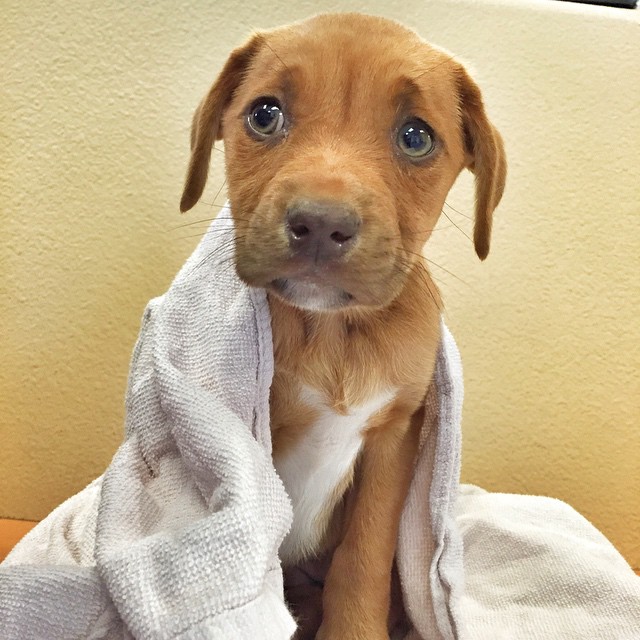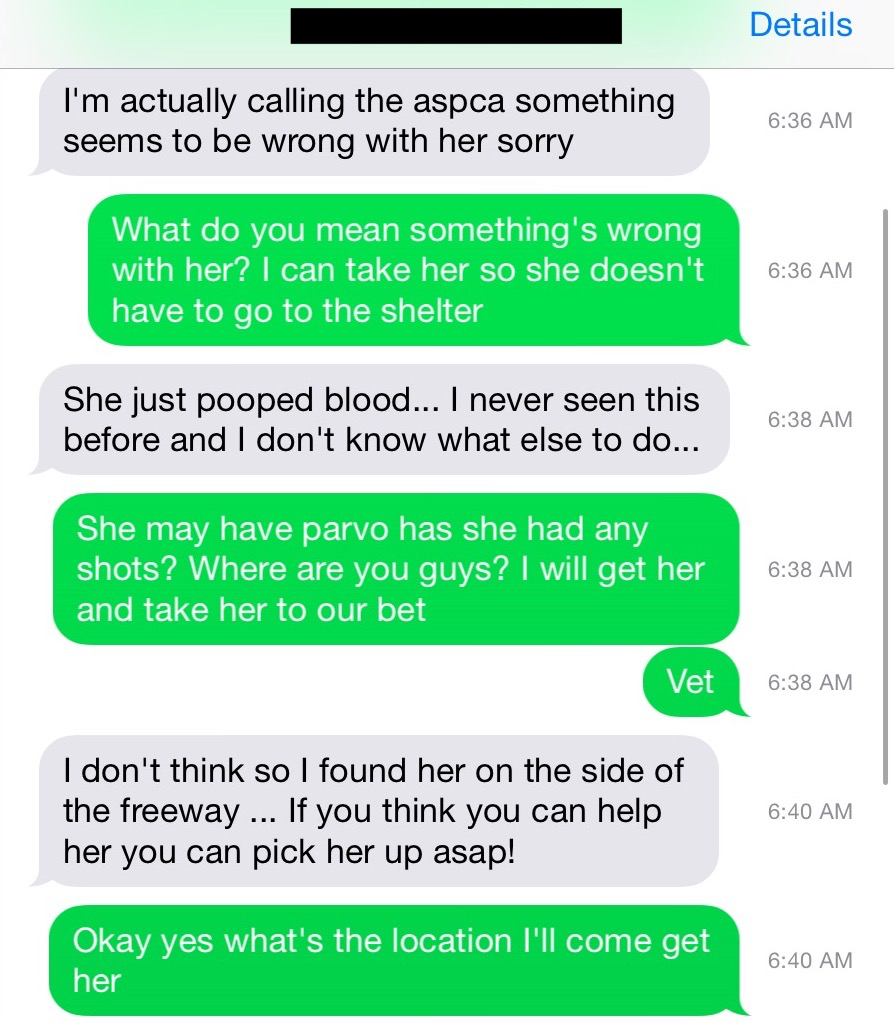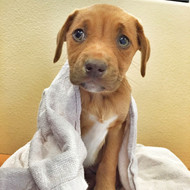The Pup Named Cora
27th Apr 2015
The Pup Named Cora

A couple days ago, I came across a craigslist ad posted by a woman trying to re-home a puppy. She wasn't very detailed in her original post, and asked for a rehoming fee- I'll admit I scrolled past it thinking it was a post from a breeder. Something in my gut told me to revisit that post, so I did, and I screen shotted it, promising to keep an eye out for the pup. The next day, there she was again, posted only an hour prior:

After reading it and realizing that perhaps the poster wasn't a breeder, but a rescuer like myself, I decided to reach out to her. I explained to her that I frequently fostered in the area, and would be happy to help her should she need it. After speaking with her for a short while, it was realized that the rescue story of the sweet pup would continue, and my part had just been set into motion:

I woke my fiancé up, told him "babe, we're rescuing a puppy. Come on", and we were out the door at 7 am. Side note: how lucky am I to have a partner who's not only supportive of my passions, but shares them with me? I have so much love for him.
About half an hour or so later, we had arrived. The woman and the puppy were on the sidewalk outside of an apartment complex waiting for us. As I approached, I already noticed the puppy's weak and lethargic state. Poor thing just didn't move. On the sidewalk before us lay a small puddle of blood (a symptom in dog's stools when affected by parvo). She was clearly a mix with her longer hair and short muzzle, and she had gorgeous green eyes. The woman was very kind, and clearly cared deeply for the puppy's well-being. She explained to us how she found the dog on the side of the freeway and really wanted to keep her, but knew her apartment wouldn't allow it and that the vet bills would just be too much to take on. After some more chit chat and pleasantries, she handed us a small bag of pedigree food, snuggled the puppy one last time, and we parted ways.
Because the pup had clear symptoms of parvovirus, I realized that she needed to go to the vet immediately. Veterinary treatment for parvovirus can be very expensive, and the bill can reach the thousands. I contacted my friends with Fresno Bully Rescue and filled them in on the situation. We were already on our way to the vet when I got a text stating that FBR agreed to take on the puppy's case. Finally, a little ray of sunshine.
When we arrived at the vet's office, the puppy started to perk up a bit, raising her head weakly through her exhaustion. I smiled and nudged my fiancé. It was like seeing a baby smile for the first time. Okay, maybe a little less dramatic-- but to us, in that moment, it felt that special. Her personality was trying to shine through her sickness. Finally, a second little ray of sunshine.
The 8 minute parvo test felt like a year. In my gut, I already knew it was the deadly virus. In my heart, I attempted to convince myself that she had something less serious, that she'd be fine, that maybe she'd even get to come back home with us that day. When the vet affirmed my worst fears, I felt both relief and devastation. I was glad that we at least knew what it was, and hopeful that we caught it early. But I have seen firsthand how ugly and deadly parvo can be.
The puppy was admitted for treatment, and we returned home. The minute we walked in the door, I was already thinking "is it too early to call and check in?" I was racking my brain thinking of a suitable name for her so I didn't have to refer to her as "the puppy" anymore. After some online searches, I came across the following excerpt:
"Cora: name of Persephone, before her return in spring causes the cycle of life to continue."
It was then decided her name would be Cora. I knew she would survive-- and not only survive, but flourish and exceed all my expectations. I envisioned her happy, moving around, smiling. At around 1:30 pm, I called the vet office to check in on Cora. They let me know that she seemed okay and that she was resting and still very lethargic. No bad news can be good news sometimes. I hated the waiting game.
At 4:12 pm I received a call from the vet. Cora had passed. She suffered agonal spasms, went unconscious, and finally let go. The virus was too strong for her weak immune system. Luckily, I could have her ashes. I had gone from picking out a brand new dog bed to planning on what to do with her cremated leftovers. Mostly, I just wished Cora could have known a better life.
Today has been a day filled with tears and pain. After the phone call, I cried uncontrollably. Fortunately, Angel came and licked my tears up. I feel lucky to have been able to help Cora transition as comfortably as possible. I am thankful for the woman who saved her and accepted my help, and I am thankful for Fresno Bully Rescue for offering theirs. A special thank you to Rebecca Corry with Stand Up For Pits Foundation. To everybody that donated towards her care: Thank you. Any leftover $ will go directly to the other adoptables in the care of FBR, and will allow them to save more animals.
If you would like to donate to Fresno Bully Rescue directly, click here.
If you would like to donate to the Stand Up For Pits Foundation, click here.
Purchase anything from Urban Suburban Apparel, and help us save more animals.
If you think your dog may have parvovirus, please take him or her to the vet immediately. And always remember to spay and neuter your pets!
-------------------------------------------------------
Parvo (Parvovirus) in Dogs
 Canine parvovirus is a highly contagious viral disease that can produce a life-threatening illness. The virus attacks rapidly dividing cells in a dog’s body, most severely affecting the intestinal tract. Parvovirus also attacks the white blood cells, and when young animals are infected, the virus can damage the heart muscle and cause lifelong cardiac problem
Canine parvovirus is a highly contagious viral disease that can produce a life-threatening illness. The virus attacks rapidly dividing cells in a dog’s body, most severely affecting the intestinal tract. Parvovirus also attacks the white blood cells, and when young animals are infected, the virus can damage the heart muscle and cause lifelong cardiac problem
What Are the General Symptoms of Parvovirus?
The general symptoms of parvovirus are lethargy, severe vomiting, loss of appetite and bloody, foul-smelling diarrhea that can lead to life-threatening dehydration.
How Is Parvovirus Transmitted?
Parvovirus is extremely contagious and can be transmitted by any person, animal or object that comes in contact with an infected dog's feces. Highly resistant, the virus can live in the environment for months, and may survive on inanimate objects such as food bowls, shoes, clothes, carpet and floors. It is common for an unvaccinated dog to contract parvovirus from the streets, especially in urban areas where there are many dogs.
Which Dogs Are Prone to Parvovirus?
Puppies, adolescent dogs and canines who are not vaccinated are most susceptible to the virus. The canine parvovirus affects most members of the dog family (wolves, coyotes, foxes, etc.). Breeds at a higher risk are Rottweilers, Doberman pinschers, Labrador retrievers, American Staffordshire terriers and German shepherds.
How Can Parvovirus Be Prevented?
You can protect your dog from this potential killer by making sure he’s up-to-date on his vaccinations. Parvovirus should be considered a core vaccine for all puppies and adult dogs. It is usually recommended that puppies be vaccinated with combination vaccines that take into account the risk factors for exposure to various diseases. One common vaccine, called a “5-in-1,” protects the puppy from distemper, hepatitis, leptospirosis, parvovirus and parainfluenza.
Generally, the first vaccine is given at 6-8 weeks of age and a booster is given at four-week intervals until the puppy is 16-20 weeks of age, and then again at one year of age. A puppy’s vaccination program is not complete before four months of age. Older dogs who have not received full puppy vaccination series may be susceptible to parvovirus and should also receive at least one immunization. Consult with your veterinarian about how often your dog will need to be revaccinated.
Because parvovirus can live in an environment for months, you will want to take extra care if there has been an infected dog in your house or yard. Some things are easier to clean and disinfect than others-and even with excellent cleaning, parvovirus can be difficult to eradicate. Parvo is resistant to many typical disinfectants. A solution of one part bleach to 32 parts water can be used where organic material is not present. The infected dog’s toys, food dish and water bowl should be properly cleaned and then disinfected with this solution for 10 minutes. If not disinfected, these articles should be discarded. You can also use the solution on the soles of your shoes if you think you've walked through an infected area. Areas that are harder to clean (grassy areas, carpeting and wood, for example) may need to be sprayed with disinfectant, or even resurfaced.
Source: http://pets.webmd.com/dogs/parvo-parvovirus-dogs?p...

